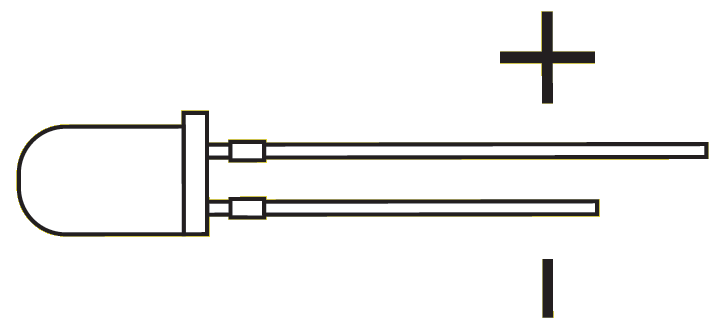LED-CUBE-3X3
Jump to navigation
Jump to search
LED-CUBE-3X3
This is UNDER CONSTRUCTION!!
Get the LED-CUBE Library HERE
Example Code:
/* ledcube.pde - Example sketch for controlling an LED cube. Created by Gamaiel Zavala (gzip), 2009-2014 MIT License. See accompanying LICENSE file for terms. */ #include <LedCube.h> #define SIZE 3 #define COLS (SIZE*SIZE) byte levelPins[SIZE] = {11,12,13}; byte colPins[COLS] = {2,3,4,5,6,7,8,9,10}; LedCube cube(SIZE, levelPins, colPins); //#define DEBUG #ifdef DEBUG #include <memdebug.h> void showmem(const char label[] = "") { char buffer[100]; sprintf(buffer,"%s: %04u %04u : used/free", label, getMemoryUsed(), getFreeMemory() ); Serial.println(buffer); } #endif void setup () { #ifdef DEBUG Serial.begin(9600); #endif } void loop () { delay(10); #ifdef DEBUG showmem("start"); #endif // paste UI output here (https://rawgithub.com/gzip/arduino-ledcube/master/ui/index.html) cubeFrame* f[] = { cube.createFrame((const byte[]) {0,6, 1,6, 2,6}, 6, 80), cube.createFrame((const byte[]) {0,7, 1,7, 2,7}, 6, 70), cube.createFrame((const byte[]) {0,8, 1,8, 2,8}, 6, 60), cube.createFrame((const byte[]) {0,5, 1,5, 2,5}, 6, 50), cube.createFrame((const byte[]) {0,2, 1,2, 2,2}, 6, 40), cube.createFrame((const byte[]) {0,1, 1,1, 2,1}, 6, 30), cube.createFrame((const byte[]) {0,0, 1,0, 2,0}, 6, 20), cube.createFrame((const byte[]) {0,3, 1,3, 2,3}, 6, 10) }; #ifdef DEBUG showmem("before free"); #endif cube.lightFrames(f, 8); // light each light one at a time for(byte level=0; level<cube.getLevels(); level++) { for(byte col=0; col<cube.getCols(); col++) { cube.lightPulse(level, col, 100); } } // light one level at a time, increasing speed each time for(byte d=25; d>2; d-=2) { for(byte l=1; l <= cube.getLevels(); l++) { cube.lightLevel(l, d); } } // light each row on each level for(byte level=1; level<=cube.getLevels(); level++) { for(byte row=1; row<=cube.getLevels()*2; row++) { cube.lightRow(row, level); } } // light each plane for(byte i=3; i; i--) { for(byte row=1; row<=cube.getLevels()*2; row++) { cube.lightPlane(row, 10*i); } } // single random light at a time cube.randomLight(random(25,100),100); // random column drop for(byte x=0; x<=15; x++) { cube.lightDrop(random(0,cube.getCols()), random(50,150)); } // circle around cube at a random level for(byte x=0; x<=5; x++) { cube.lightPerimeter(random(0,cube.getLevels()), random(1,5), random(25,100)); } // light each face byte planes[] = {cube.getLevels()+1,cube.getLevels(),cube.getLevels()*2,1}; for(byte i=5; i; i--) { for(byte p=0; p<sizeof(planes); p++) { cube.lightPlane(planes[p], 5*i); } } // random columns cube.randomColumn(25); // turn off a single column randomly cube.enableBuffer(); for(byte c=0; c<30; c++) { cube.fillBuffer(); cube.invertBuffer(); cube.randomColumn(); cube.drawBuffer(7); } cube.enableBuffer(false); // cols in and out for(byte c=1, d=0; c<=10; c++) { if(c%2 == 0) { for(d=0; d<20; d++) { cube.lightColumn(2,1); cube.lightColumn(4,1); cube.lightColumn(6,1); cube.lightColumn(8,1); } } else if(c%4 == 1) { for(d=0; d<30; d++) { cube.lightColumn(1,1); cube.lightColumn(3,1); cube.lightColumn(7,1); cube.lightColumn(9,1); } } else { for(d=0; d<70; d++) { cube.lightColumn(5,1); } } } // diamond and box byte diamond[] = {0,4, 1,1, 1,3, 1,4, 1,5, 1,7, 2,4}; byte box[] = { 2,0, 2,1, 2,2, 2,3, 2,5, 2,6, 2,7, 2,8, 1,0, 1,2, 1,6, 1,8, 0,0, 0,1, 0,2, 0,3, 0,5, 0,6, 0,7, 0,8 }; cube.lightSequence(box, sizeof(box), 200); cube.lightSequence(diamond, sizeof(diamond), 400); // helicopter effect byte topSeq[8] = {0,3,6,7,8,5,2,1}; byte botSeq[8] = {8,5,2,1,0,3,6,7}; for(byte loops = 0, delay = 50; loops<=8; loops++) { for(byte s=0; s<8; s++) { byte seq[] = {2,topSeq[s], 1,4, 0,botSeq[s]}; cube.lightSequence(seq, sizeof(seq), delay); } if(loops < 5) delay-=10; else delay += 10; } // turn off one light at a time cube.lightsOut(); }
